High-Resolution Daily Emission Inventory of Biomass Burning in the Amur-Heilong River Basin Based on MODIS Fire Radiative Energy Data
Abstract
1. Introduction
2. Data and Methods
2.1. Study Area
2.2. Datasets
2.3. Methods
2.3.1. Estimation of Fire Radiation Power (FRP)
2.3.2. Standard Deviation Ellipse Analysis
3. Results and Discussion
3.1. Spatial Distribution of CO2 Emissions
3.2. Temporal Pattern of CO2 Emissions
3.2.1. Annual Variations
3.2.2. Monthly Variations
3.2.3. Spatiotemporal Variation
3.3. Daily CO2 Emissions from Biomass Burning
3.4. Comparison with Other Studies
4. Conclusions
Author Contributions
Funding
Data Availability Statement
Acknowledgments
Conflicts of Interest
References
- Kasischke, E.S.; Hoy, E.E. Controls on carbon consumption during Alaskan wildland fires. Glob. Chang. Biol. 2012, 18, 685–699. [Google Scholar] [CrossRef]
- Shi, Y.; Matsunaga, T.; Yamaguchi, Y. High-Resolution Mapping of Biomass Burning Emissions in Three Tropical Regions. Environ. Sci. Technol. 2015, 49, 10806–10814. [Google Scholar] [CrossRef]
- Wiedinmyer, C.; Akagi, S.K.; Yokelson, R.J.; Emmons, L.K.; Al-Saadi, J.A.; Orlando, J.J.; Soja, A.J. The Fire INventory from NCAR (FINN): A high resolution global model to estimate the emissions from open burning. Geosci. Model. Dev. 2011, 4, 625–641. [Google Scholar] [CrossRef]
- Freeborn, P.H.; Wooster, M.J.; Roy, D.P.; Cochrane, M.A. Quantification of MODIS fire radiative power (FRP) measurement uncertainty for use in satellite-based active fire characterization and biomass burning estimation. Geophys. Res. Lett. 2014, 41, 1988–1994. [Google Scholar] [CrossRef]
- Lv, Z.; Shi, Y.; Zang, S.; Sun, L. Spatial and Temporal Variations of Atmospheric CO2 Concentration in China and Its Influencing Factors. Atmosphere 2020, 11, 231. [Google Scholar] [CrossRef]
- Van der Werf, G.R.; Randerson, J.T.; Giglio, L.; van Leeuwen, T.T.; Chen, Y.; Rogers, B.M.; Mu, M.; van Marle, M.J.E.; Morton, D.C.; Collatz, G.J.; et al. Global fire emissions estimates during 1997–2016. Earth Syst. Sci. Data 2017, 9, 697–720. [Google Scholar] [CrossRef]
- Baccini, A.; Goetz, S.J.; Walker, W.S.; Laporte, N.T.; Sun, M.; Sulla-Menashe, D.; Hackler, J.; Beck, P.S.A.; Dubayah, R.; Friedl, M.A.; et al. Estimated carbon dioxide emissions from tropical deforestation improved by carbon-density maps. Nat. Clim. Chang. 2012, 2, 182–185. [Google Scholar] [CrossRef]
- Shi, Y.; Sasai, T.; Yamaguchi, Y. Spatio-temporal evaluation of carbon emissions from biomass burning in Southeast Asia during the period 2001–2010. Ecol. Model. 2014, 272, 98–115. [Google Scholar] [CrossRef]
- Friedlingstein, P.; O’Sullivan, M.; Jones, M.W.; Andrew, R.M.; Hauck, J.; Olsen, A.; Peters, G.P.; Peters, W.; Pongratz, J.; Sitch, S.; et al. Global Carbon Budget 2020. Earth Syst. Sci. Data 2020, 12, 3269–3340. [Google Scholar] [CrossRef]
- Chen, Y.; Morton, D.C.; Andela, N.; van der Werf, G.R.; Giglio, L.; Randerson, J.T. A pan-tropical cascade of fire driven by El Niño/Southern Oscillation. Nat. Clim. Chang. 2017, 7, 906–911. [Google Scholar] [CrossRef]
- Tian, J.; Wang, Q.; Ni, H.; Wang, M.; Zhou, Y.; Han, Y.; Shen, Z.; Pongpiachan, S.; Zhang, N.; Zhao, Z.; et al. Emission Characteristics of Primary Brown Carbon Absorption From Biomass and Coal Burning: Development of an Optical Emission Inventory for China. J. Geophys. Res. Atmos. 2019, 124, 1879–1893. [Google Scholar] [CrossRef]
- Le Quéré, C.; Andrew, R.M.; Friedlingstein, P.; Sitch, S.; Hauck, J.; Pongratz, J.; Pickers, P.A.; Korsbakken, J.I.; Peters, G.P.; Canadell, J.G.; et al. Global Carbon Budget 2018. Earth Syst. Sci. Data 2018, 10, 2141–2194. [Google Scholar] [CrossRef]
- Yokelson, R.J.; Christian, T.J.; Karl, T.G.; Guenther, A. Corrigendum to “The tropical forest and fire emissions experiment: Laboratory fire measurements and synthesis of campaign data“ published in Atmos. Chem. Phys., 8, 3509–3527, 2008. Atmos. Chem. Phys. 2008, 8, 4497. [Google Scholar] [CrossRef][Green Version]
- Akagi, S.K.; Yokelson, R.J.; Wiedinmyer, C.; Alvarado, M.J.; Reid, J.S.; Karl, T.; Crounse, J.D.; Wennberg, P.O. Emission factors for open and domestic biomass burning for use in atmospheric models. Atmos. Chem. Phys. 2011, 11, 4039–4072. [Google Scholar] [CrossRef]
- Bond, T.C.; Doherty, S.J.; Fahey, D.W.; Forster, P.M.; Berntsen, T.; DeAngelo, B.J.; Flanner, M.G.; Ghan, S.; Kärcher, B.; Koch, D.; et al. Bounding the role of black carbon in the climate system: A scientific assessment. J. Geophys. Res. Atmos. 2013, 118, 5380–5552. [Google Scholar] [CrossRef]
- Olivier, J.G.J.; Van Aardenne, J.A.; Dentener, F.J.; Pagliari, V.; Ganzeveld, L.N.; Peters, J.A.H.W. Recent trends in global greenhouse gas emissions:regional trends 1970–2000 and spatial distributionof key sources in 2000. Environ. Sci. 2007, 2, 81–99. [Google Scholar] [CrossRef]
- Shi, Y.; Zhao, A.; Matsunaga, T.; Yamaguchi, Y.; Zang, S.; Li, Z.; Yu, T.; Gu, X. High-resolution inventory of mercury emissions from biomass burning in tropical continents during 2001–2017. Sci. Total Environ. 2019, 653, 638–648. [Google Scholar] [CrossRef]
- Yin, L.; Du, P.; Zhang, M.; Liu, M.; Xu, T.; Song, Y. Estimation of emissions from biomass burning in China (2003–2017) based on MODIS fire radiative energy data. Biogeosciences 2019, 16, 1629–1640. [Google Scholar] [CrossRef]
- Shi, Y.; Gong, S.; Zang, S.; Zhao, Y.; Wang, W.; Lv, Z.; Matsunaga, T.; Yamaguchi, Y.; Bai, Y. High-resolution and multi-year estimation of emissions from open biomass burning in Northeast China during 2001–2017. J. Clean. Prod. 2021, 310, 127496. [Google Scholar] [CrossRef]
- Shi, Y.; Yamaguchi, Y. A high-resolution and multi-year emissions inventory for biomass burning in Southeast Asia during 2001–2010. Atmos. Environ. 2014, 98, 8–16. [Google Scholar] [CrossRef]
- Seiler, W.; Crutzen, P.J. Estimates of gross and net fluxes of carbon between the biosphere and the atmosphere from biomass burning. Clim. Chang. 1980, 2, 207–247. [Google Scholar] [CrossRef]
- Shi, Y.; Zang, S.; Matsunaga, T.; Yamaguchi, Y. A multi-year and high-resolution inventory of biomass burning emissions in tropical continents from 2001–2017 based on satellite observations. J. Clean. Prod. 2020, 270, 122511. [Google Scholar] [CrossRef]
- Qiu, X.; Duan, L.; Chai, F.; Wang, S.; Yu, Q.; Wang, S. Deriving High-Resolution Emission Inventory of Open Biomass Burning in China based on Satellite Observations. Environ. Sci. Technol. 2016, 50, 11779–11786. [Google Scholar] [CrossRef] [PubMed]
- Giglio, L.; Randerson, J.T.; van der Werf, G.R. Analysis of daily, monthly, and annual burned area using the fourth-generation global fire emissions database (GFED4). J. Geophys. Res. Biogeosci. 2013, 118, 317–328. [Google Scholar] [CrossRef]
- Liu, M.; Song, Y.; Yao, H.; Kang, Y.; Li, M.; Huang, X.; Hu, M. Estimating emissions from agricultural fires in the North China Plain based on MODIS fire radiative power. Atmos. Environ. 2015, 112, 326–334. [Google Scholar] [CrossRef]
- Song, Y.; Di, C.; Bing, L.; Miao, W.; Zhang, Y.; Zhu, L. A new emission inventory for nonagricultural open fires in Asia from 2000 to 2009. Environ. Res. Lett. 2010, 5, 14014–14016. [Google Scholar] [CrossRef]
- Pan, X.; Ichoku, C.; Chin, M.; Bian, H.; Darmenov, A.; Colarco, P.; Ellison, L.; Kucsera, T.; da Silva, A.; Wang, J.; et al. Six global biomass burning emission datasets: Intercomparison and application in one global aerosol model. Atmos. Chem. Phys. 2020, 20, 969–994. [Google Scholar] [CrossRef]
- Song, Y.; Liu, B.; Miao, W.; Chang, D.; Zhang, Y. Spatiotemporal variation in nonagricultural open fire emissions in China from 2000 to 2007. Glob. Biogeochem. Cycles 2009, 23. [Google Scholar] [CrossRef]
- Xu, W.; Wooster, M.J.; Kaneko, T.; He, J.; Zhang, T.; Fisher, D. Major advances in geostationary fire radiative power (FRP) retrieval over Asia and Australia stemming from use of Himarawi-8 AHI. Remote Sens. Environ. 2017, 193, 138–149. [Google Scholar] [CrossRef]
- Li, F.; Zhang, X.; Roy, D.P.; Kondragunta, S. Estimation of biomass-burning emissions by fusing the fire radiative power retrievals from polar-orbiting and geostationary satellites across the conterminous United States. Atmos. Environ. 2019, 211, 274–287. [Google Scholar] [CrossRef]
- Li, F.; Zhang, X.; Kondragunta, S.; Csiszar, I. Comparison of Fire Radiative Power Estimates From VIIRS and MODIS Observations. J. Geophys. Res. Atmos. 2018, 123, 4545–4563. [Google Scholar] [CrossRef]
- Yin, S. Biomass burning spatiotemporal variations over South and Southeast Asia. Environ. Int. 2020, 145, 106153. [Google Scholar] [CrossRef] [PubMed]
- Wooster, M.J.; Roberts, G.; Perry, G.L.W.; Kaufman, Y.J. Retrieval of biomass combustion rates and totals from fire radiative power observations: FRP derivation and calibration relationships between biomass consumption and fire radiative energy release. J. Geophys. Res. 2005, 110, 1–24. [Google Scholar] [CrossRef]
- Zhang, T.; Wooster, M.J.; Green, D.C.; Main, B. New field-based agricultural biomass burning trace gas, PM 2.5, and black carbon emission ratios and factors measured in situ at crop residue fires in Eastern China. Atmos. Environ. 2015, 121, 22–34. [Google Scholar] [CrossRef]
- Giglio, L.; Schroeder, W.; Justice, C.O. The collection 6 MODIS active fire detection algorithm and fire products. Remote Sens. Environ. 2016, 178, 31–41. [Google Scholar] [CrossRef]
- Freeborn, P.H.; Wooster, M.J.; Hao, W.M.; Ryan, C.A.; Nordgren, B.L.; Baker, S.P.; Ichoku, C. Relationships between energy release, fuel mass loss, and trace gas and aerosol emissions during laboratory biomass fires. J. Geophys. Res. 2008, 113, 16. [Google Scholar] [CrossRef]
- Wooster, M.J. Small-scale experimental testing of fire radiative energy for quantifying mass combusted in natural vegetation fires. Geophys. Res. Lett. 2002, 29, 23. [Google Scholar] [CrossRef]
- Giglio, L. MODIS Collection 6 Active Fire Product User’s Guide Revision A. Environ. Sci. 2015. [Google Scholar]
- Kaiser, J.; Suttie, M.; Flemming, J.; Morcrette, J.J.; Boucher, O.; Schultz, M. Global real-time fire emission estimates based on space-borne fire radiative power observations. In AIP Conference Proceedings; American Institute of Physics: College Park, MD, USA, 2009; pp. 645–648. [Google Scholar] [CrossRef]
- Kaiser, J.; Heil, A.; Andreae, M.; Benedetti, A.; Chubarova, N.; Jones, L.; Morcrette, J.-J.; Razinger, M.; Schultz, M.; Suttie, M. Biomass burning emissions estimated with a global fire assimilation system based on observed fire radiative power. Biogeosciences 2012, 9, 527–554. [Google Scholar] [CrossRef]
- Liu, T.; Mickley, L.J.; Marlier, M.E.; DeFries, R.S.; Khan, M.F.; Latif, M.T.; Karambelas, A. Diagnosing spatial biases and uncertainties in global fire emissions inventories: Indonesia as regional case study. Remote Sens. Environ. 2020, 237, 111557. [Google Scholar] [CrossRef]
- Takami, K.; Shimadera, H.; Uranishi, K.; Kondo, A. Impacts of Biomass Burning Emission Inventories and Atmospheric Reanalyses on Simulated PM10 over Indochina. Atmosphere 2020, 11, 160. [Google Scholar] [CrossRef]
- Zhou, S.; Zhang, W.; Guo, Y. Impacts of Climate and Land-Use Changes on the Hydrological Processes in the Amur River Basin. Water 2019, 12, 76. [Google Scholar] [CrossRef]
- Yan, B.; Xia, Z.; Huang, F.; Guo, L.; Zhang, X. Climate Change Detection and Annual Extreme Temperature Analysis of the Amur River Basin. Adv. Meteorol. 2016, 2016, 1–14. [Google Scholar] [CrossRef]
- Zou, Y.; Wang, L.; Xue, Z.; E, M.; Jiang, M.; Lu, X.; Yang, S.; Shen, X.; Liu, Z.; Sun, G.; et al. Impacts of Agricultural and Reclamation Practices on Wetlands in the Amur River Basin, Northeastern China. Wetlands 2017, 38, 383–389. [Google Scholar] [CrossRef]
- Mao, D.; Tian, Y.; Wang, Z.; Jia, M.; Du, J.; Song, C. Wetland changes in the Amur River Basin: Differing trends and proximate causes on the Chinese and Russian sides. J. Environ. Manag. 2021, 280, 111670. [Google Scholar] [CrossRef] [PubMed]
- Guo, D.; Wang, C.; Zang, S.; Hua, J.; Lv, Z.; Lin, Y. Gap-Filling of 8-Day Terra MODIS Daytime Land Surface Temperature in High-Latitude Cold Region with Generalized Additive Models (GAM). Remote Sens. 2021, 13, 3667. [Google Scholar] [CrossRef]
- Zhang, T.; de Jong, M.C.; Wooster, M.J.; Xu, W.; Wang, L. Trends in eastern China agricultural fire emissions derived from a combination of geostationary (Himawari) and polar (VIIRS) orbiter fire radiative power products. Atmos. Chem. Phys. 2020, 20, 10687–10705. [Google Scholar] [CrossRef]
- Li, F.; Zhang, X.; Kondragunta, S. Biomass Burning in Africa: An Investigation of Fire Radiative Power Missed by MODIS Using the 375 m VIIRS Active Fire Product. Remote Sens. 2020, 12, 1561. [Google Scholar] [CrossRef]
- Vermote, E.; Ellicott, E.; Dubovik, O.; Lapyonok, T.; Chin, M.; Giglio, L.; Roberts, G.J. An approach to estimate global biomass burning emissions of organic and black carbon from MODIS fire radiative power. J. Geophys. Res. Atmos. 2009, 114, D18205. [Google Scholar] [CrossRef]
- Shen, Y.; Jiang, C.; Chan, K.L.; Hu, C.; Yao, L. Estimation of Field-Level NOx Emissions from Crop Residue Burning Using Remote Sensing Data: A Case Study in Hubei, China. Remote Sens. 2021, 13, 404. [Google Scholar] [CrossRef]
- He, Q.; Gu, Y.; Zhang, M. Spatiotemporal patterns of aerosol optical depth throughout China from 2003 to 2016. Sci. Total Environ. 2019, 653, 23–35. [Google Scholar] [CrossRef] [PubMed]
- Shi, Y.; Zhao, A.; Matsunaga, T.; Yamaguchi, Y.; Zang, S.; Li, Z.; Yu, T.; Gu, X. Underlying causes of PM2.5-induced premature mortality and potential health benefits of air pollution control in South and Southeast Asia from 1999 to 2014. Environ. Int. 2018, 121, 814–823. [Google Scholar] [CrossRef] [PubMed]
- Andreae, M.O.; Rosenfeld, D. Aerosol cloud precipitation interactions. Part 1. The nature and sources of cloud-active aerosols. Earth Sci. Rev. 2008, 89, 13–41. [Google Scholar] [CrossRef]
- Mcmeeking, G.R. The Optical, Chemical, and Physical Properties of Aerosols and Gases Emitted by the Laboratory Combustion of Wildland Fuels. Ph.D. Thesis, Department of Atmospheric Sciences, Colorado State University, Fort Collins, CO, USA, 2008. [Google Scholar]
- Cao, G.L.; Zhang, X.Y.; Zheng, F.C.; Wang, Y.Q. Estimating the quantity of crop residues burnt in open field in China. Resour. Sci. 2006, 16, 502–508. [Google Scholar] [CrossRef]
- Shvidenko, A.Z.; Shchepashchenko, D.G.; Vaganov, E.A.; Sukhinin, A.I.; Maksyutov, S.S.; McCallum, I.; Lakyda, I.P. Impact of wildfire in Russia between 1998–2010 on ecosystems and the global carbon budget. Dokl. Earth Sci. 2012, 441, 1678–1682. [Google Scholar] [CrossRef]
- Hayasaka, H.; Sokolova, G.V.; Ostroukhov, A.; Naito, D. Classification of Active Fires and Weather Conditions in the Lower Amur River Basin. Remote Sens. 2020, 12, 3204. [Google Scholar] [CrossRef]
- Mollicone, D.; Eva, H.D.; Achard, F.J.N. Human role in Russian wild fires. Nature 2006, 440, 436–437. [Google Scholar] [CrossRef]
- Shi, T.T.; Liu, Y.Q.; Zhang, L.B.; Hao, L.; Gao, Z.Q. Burning in agricultural landscapes: An emerging natural and human issue in China. Landsc. Ecol. 2014, 29, 1785–1798. [Google Scholar] [CrossRef]
- Jargalsaikhan, D.; Darhijav, B.; Rentsen, T. Estimation of crop suitability using NDVI in The Kherlen Basin Dornod province Mongolia. Int. J. Sci. Environ. Technol. 2021, 10, 19–21. [Google Scholar]
- Wang, J.; Cheng, K.; Liu, Q.; Zhu, J.; Ochir, A.; Davaasuren, D.; Li, G.; Wei, H.; Chonokhuu, S.; Namsrai, O. Land cover patterns in Mongolia and their spatiotemporal changes from 1990 to 2010. Arab. J. Geosci. 2019, 12, 1–13. [Google Scholar] [CrossRef]
- Damoah, R.; Spichtinger, N.; Forster, C.; James, P.; Mattis, I.; Wandinger, U.; Beirle, S.; Wagner, T.; Stohl, A. Around the world in 17 days—hemispheric-scale transport of forest fire smoke from Russia in May 2003. Atmos. Chem. Phys. 2004, 4, 1311–1321. [Google Scholar] [CrossRef]
- Kim, J.S.; Kug, J.S.; Jeong, S.J.; Park, H.; Schaepman-Strub, G. Extensive fires in southeastern Siberian permafrost linked to preceding Arctic Oscillation. Sci. Adv. 2020, 6, eaax3308. [Google Scholar] [CrossRef] [PubMed]
- Sukhomlinov, N.R.; Sukhomlinova, V.V. Fire damage to plants in coniferous-deciduous forests in the Middle Amur region and their indicator significance. Contemp. Probl. Ecol. 2011, 4, 303–309. [Google Scholar] [CrossRef]
- Yan, C.; Yan, S.S.; Jia, T.Y.; Dong, S.K.; Gong, Z.P. Decomposition characteristics of rice straw returned to the soil in northeast China. Nutr. Cycl. Agroecosyst. 2019, 114, 211–224. [Google Scholar] [CrossRef]
- Stankowski, S.; Chajduk, E.; Osińska, B.; Gibczyńska, M. Biomass ash as a potential raw material for the production of mineral fertilisers. Agron. Res. 2021, 19, 1999–2012. [Google Scholar] [CrossRef]
- Lee, K.H.; Kim, J.E.; Kim, Y.J.; Kim, J.; Hoyningen-Huene, W.V. Impact of the Smoke Aerosol from Russian Forest Fires on the Atmospheric Environment over Korea during May 2003. Atmos. Environ. 2005, 39, 85–99. [Google Scholar] [CrossRef]
- Vivchar, A. Wildfires in Russia in 2000–2008: Estimates of burnt areas using the satellite MODIS MCD45 data. Remote Sens. Lett. 2011, 2, 81–90. [Google Scholar] [CrossRef]
- Warneke, C.; Bahreini, R.; Brioude, J.; Brock, C.A.; De Gouw, J.A.; Fahey, D.W.; Froyd, K.D.; Holloway, J.S.; Middlebrook, A.; Miller, L. Biomass burning in Siberia and Kazakhstan as an important source for haze over the Alaskan Arctic in April 2008. Geophys. Res. Lett. 2009, 36, L02813. [Google Scholar] [CrossRef]
- Andela, N.; Kaiser, J.W.; Heil, A.; Leeuwen, T.V.; Van, D.; Wooster, M.J.; Remy, S.; Schultz, M. Assessment of the Global Fire Assimilation System (GFASv1); Deliverable D_31.2; MACC-II: Amsterdam, The Netherlands, 2013. [Google Scholar] [CrossRef]
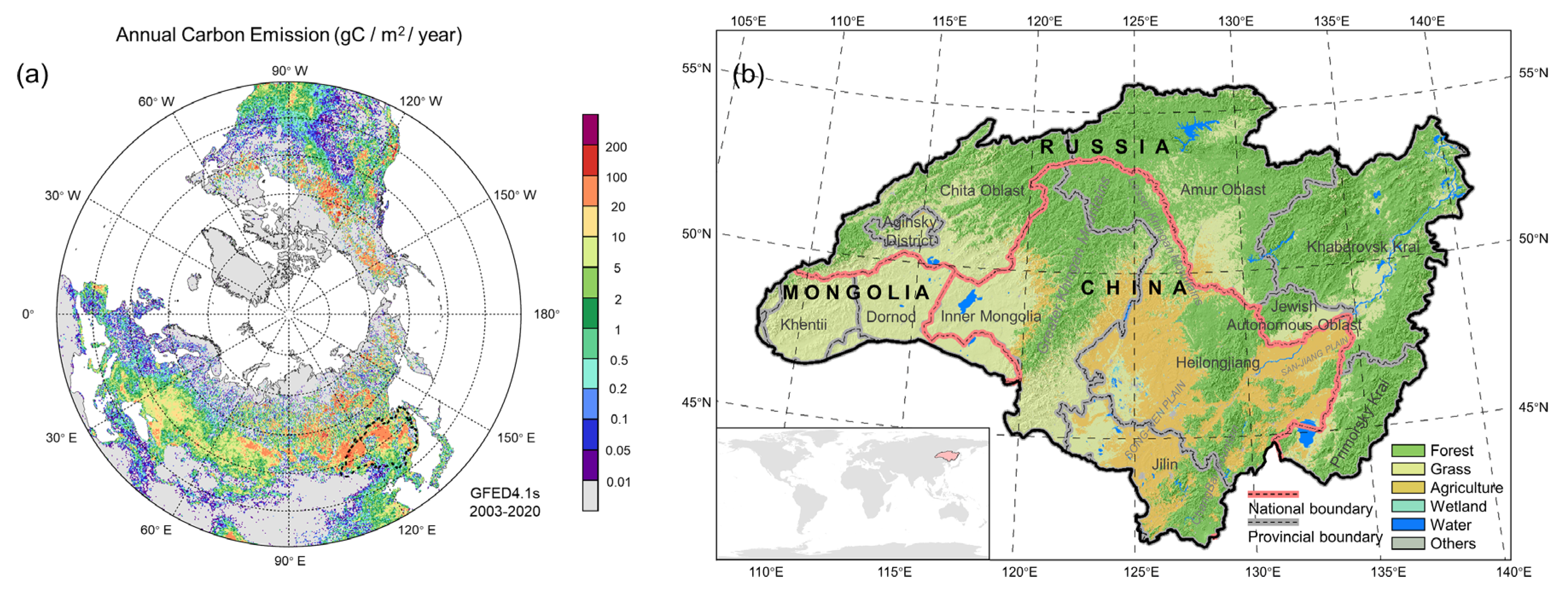

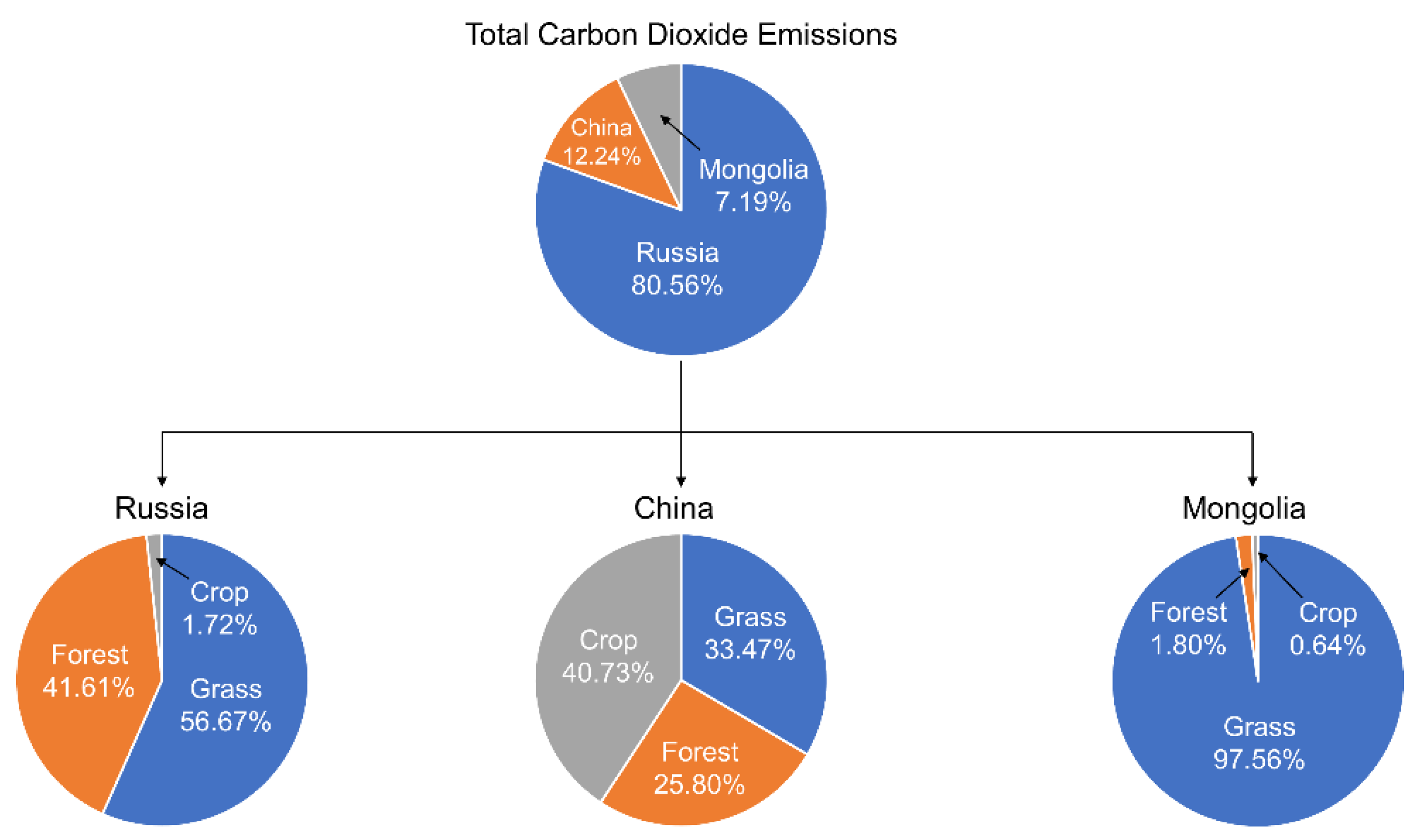
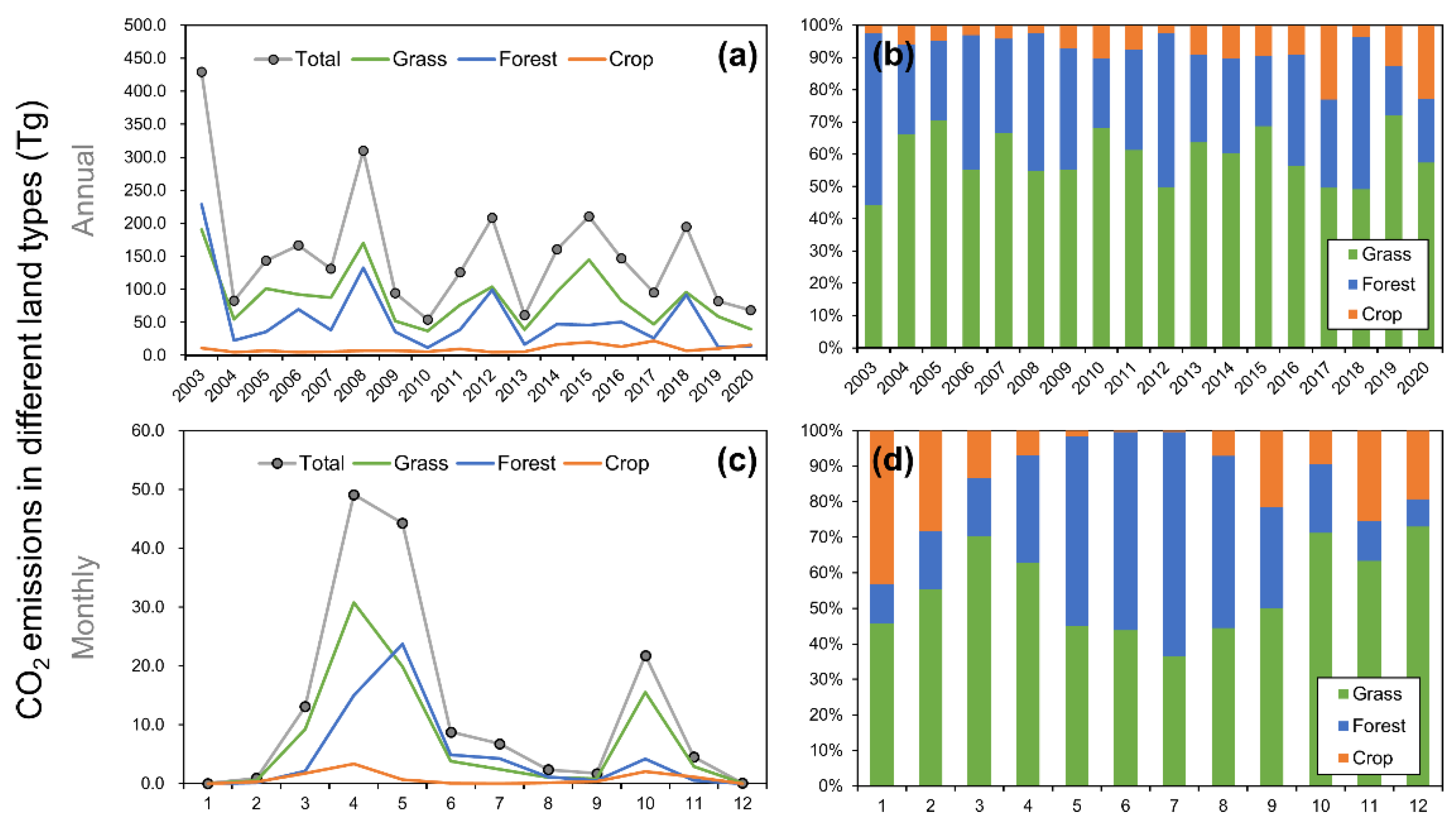
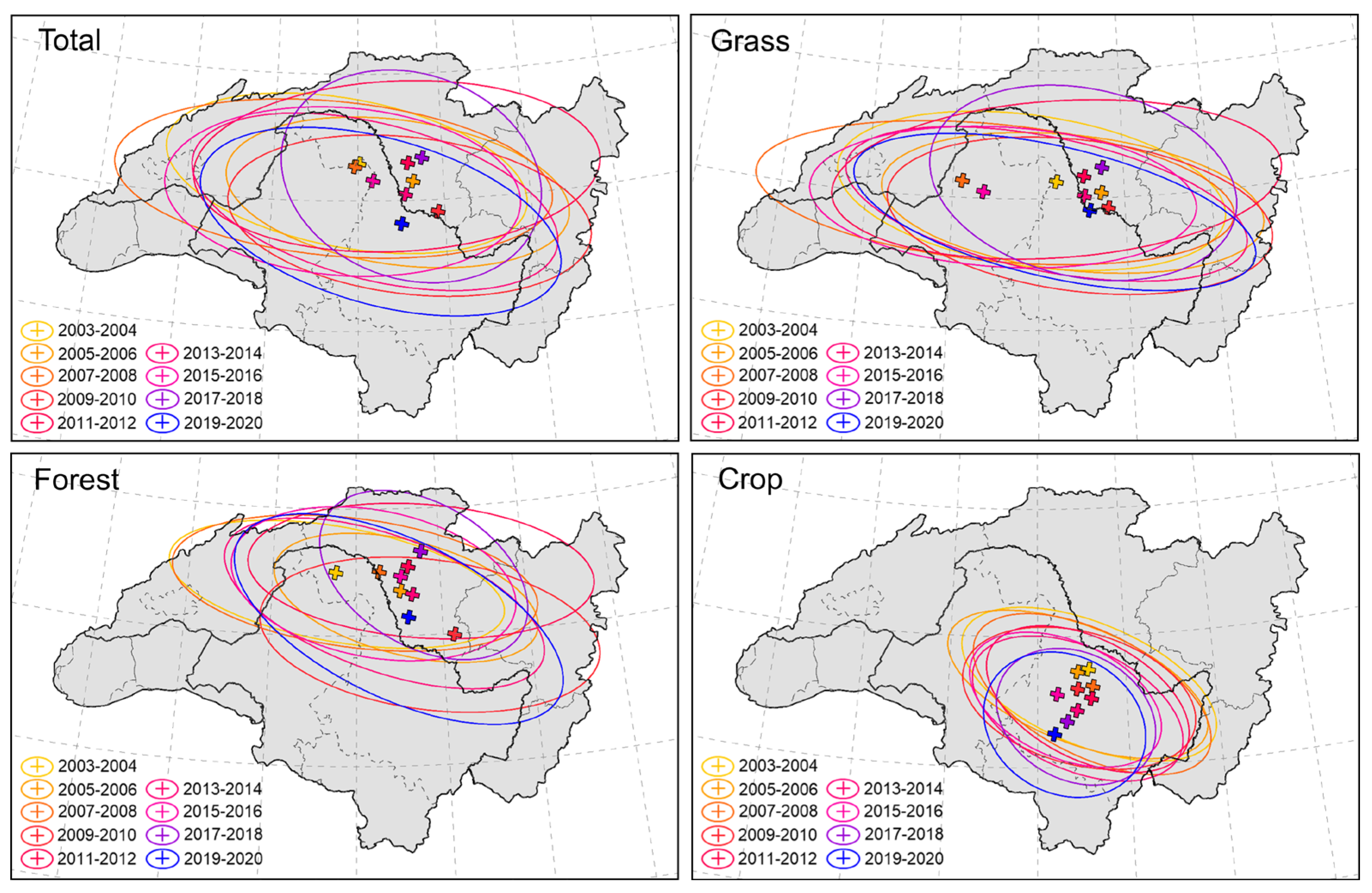

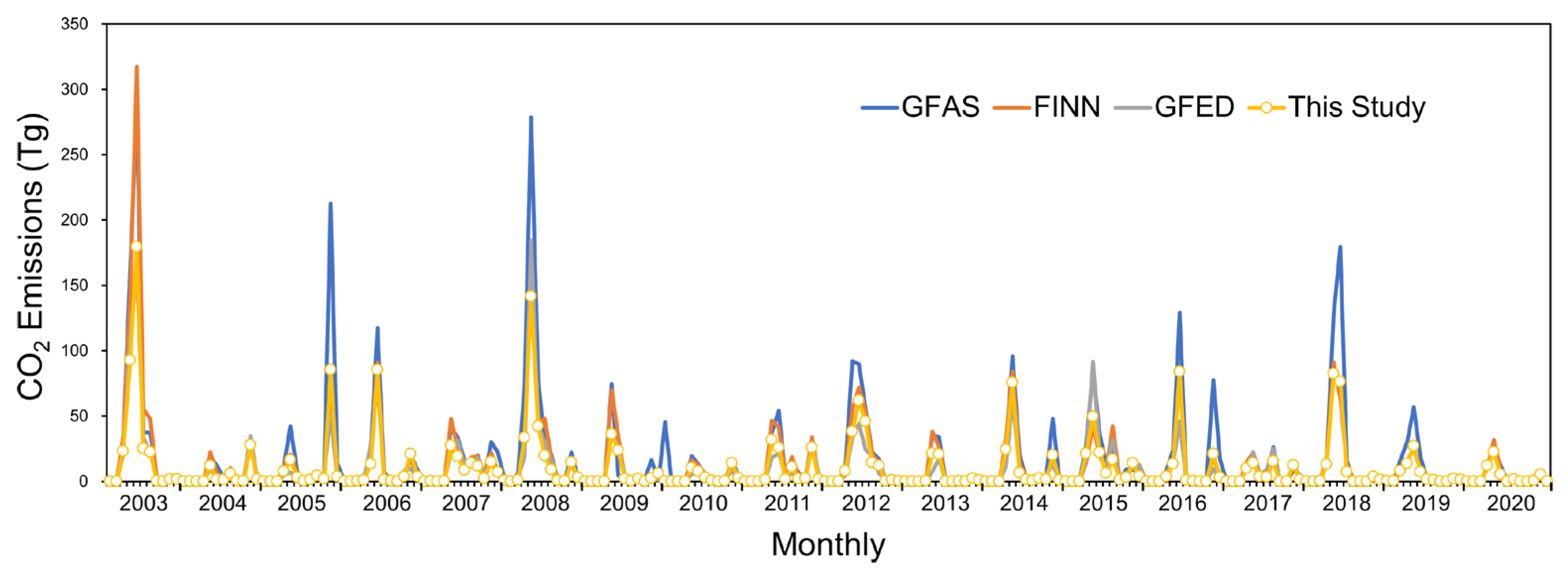
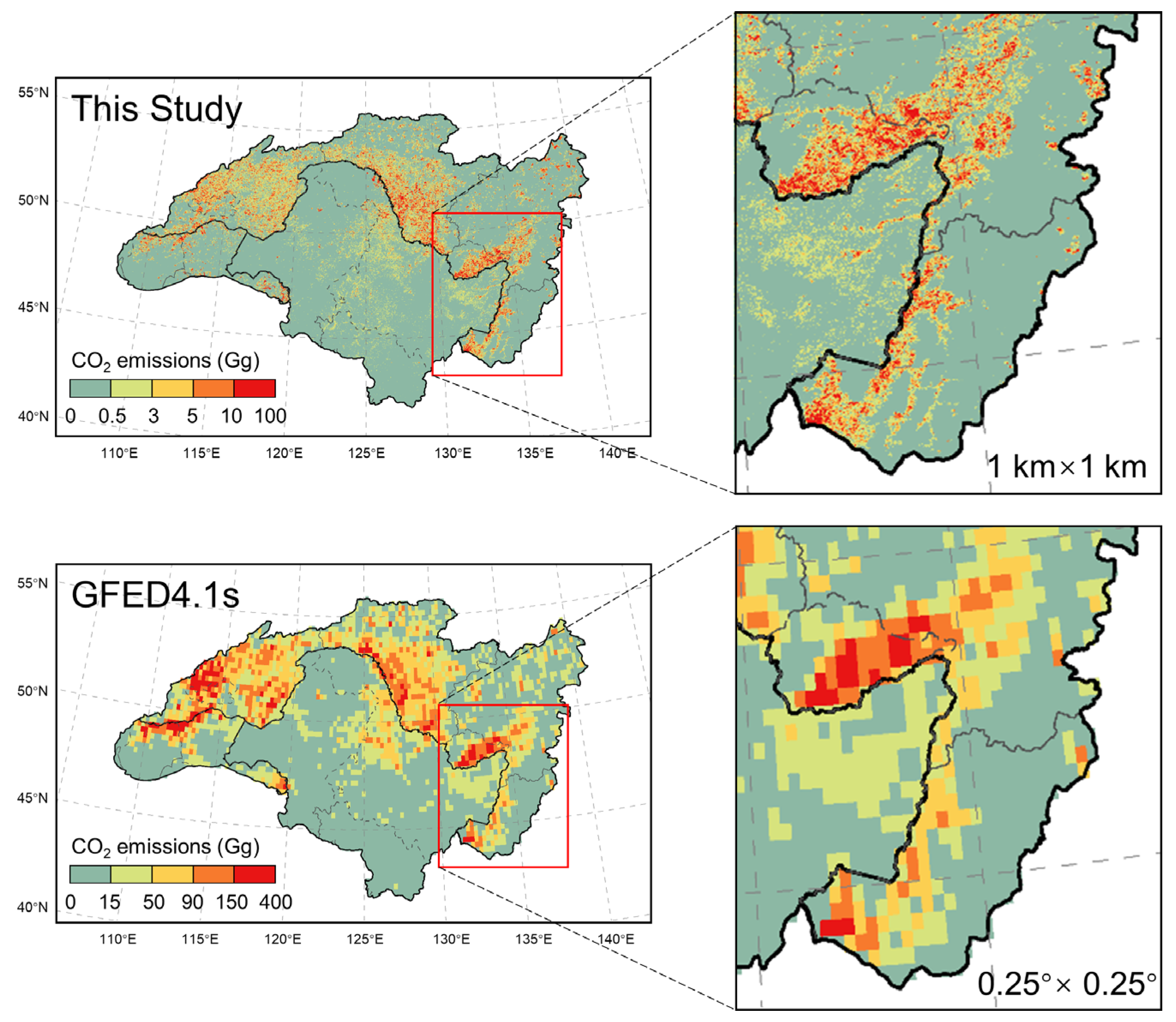
| IGBP | This Study | IGBP | This Study |
|---|---|---|---|
| 1. Evergreen Needleleaf Forests | Forest | 10. Grasslands | Grassland |
| 2. Evergreen Broadleaf Forests | - | 11. Permanent Wetlands | Wetland |
| 3. Deciduous Needleleaf Forests | Forest | 12. Croplands | Agriculture |
| 4. Deciduous Broadleaf Forests | Forest | 13. Urban and Built-up Lands | Others |
| 5. Mixed Forests | Forest | 14. Cropland/Natural Vegetation Mosaics | Agriculture |
| 6. Closed Shrublands | Forest | 15. Permanent Snow and Ice | Others |
| 7. Open Shrublands | Forest | 16. Barren | Others |
| 8. Woody Savannas | Forest | 17. Water Bodies | Water |
| 9. Savannas | Grassland |
| Category | Land Use Type | CO2 | CO | CH4 | NMOCs | NOx | NH3 | SO2 | BC | OC | PM2.5 | PM10 |
|---|---|---|---|---|---|---|---|---|---|---|---|---|
| (IGBP) | Unit: g kg−1 | |||||||||||
| Forest | Evergreen Needleleaf Forest | 1514.0 a | 118.0 a | 6.0 a | 28.0 a | 1.8 c | 2.5 a | 1.0 c | 0.8 d | 7.8 f | 12.7 e | 13.1 e |
| Evergreen Broadleaf Forest | - | - | - | - | - | - | - | - | - | - | - | |
| Deciduous Needleleaf Forest | 1514.0 a | 118.0 a | 6.0 a | 28.0 a | 3.0 c | 3.5 a | 1.0 c | 0.8 d | 7.8 f | 12.7 e | 13.1 e | |
| Deciduous Broadleaf Forest | 1630.0 a | 102.0 a | 5.0 a | 11.0 a | 1.3 a | 1.5 a | 1.0 c | 0.8 d | 9.2 a | 12.3 e | 12.8 e | |
| Mixed Forest | 1630.0 a | 102.0 a | 5.0 a | 14.0 a | 1.3 a | 1.5 a | 1.0 c | 0.8 d | 9.2 a | 12.3 e | 12.8 e | |
| Closed Shrublands | 1716.0 a | 68.0 a | 2.6 a | 4.8 a | 3.9 a | 1.2 a | 0.7 a | 0.5 d | 6.6 f | 7.9 e | 8.5 e | |
| Open Shrublands | 1716.0 a | 68.0 a | 2.6 a | 4.8 a | 3.9 a | 1.2 a | 0.7 a | 0.5 d | 6.6 f | 7.9 e | 8.5 e | |
| Woody Savannas | 1716.0 a | 68.0 a | 2.6 a | 4.8 a | 3.9 a | 1.2 a | 0.7 a | 0.4 d | 6.6 f | 7.9 e | 8.5 e | |
| Grass | Savannas | 1692.0 a | 59.0 a | 1.5 a | 9.3 a | 2.8 a | 0.5 a | 0.7 a | 0.4 d | 2.6 d | 6.3 e | 9.9 e |
| Grasslands | 1692.0 a | 59.0 a | 1.5 a | 9.3 a | 2.8 a | 0.5 a | 0.7 a | 0.5 d | 2.6 d | 6.3 e | 9.9 e | |
| Crop | Cropland | 1353.5 b | 76.1 b | 2.8 b | 9.8 b | 2.9 b | 1.4 b | 0.4 b | 0.6 d | 2.0 d | 5.0 b | 6.3 b |
| Cropland/Natural Vegetation Mosaics | 1669.4 b | 84.7 b | 3.4 b | 5.8 b | 3.5 b | 0.9 b | 0.5 b | 0.5 d | 6.3 d | 7.9 b | 8.5 b | |
| CO2 | CO | CH4 | NMOCs | NOx | NH3 | SO2 | BC | OC | PM2.5 | PM10 | |
|---|---|---|---|---|---|---|---|---|---|---|---|
| 2003 | 430.00 | 17.00 | 0.59 | 2.00 | 0.82 | 0.24 | 0.18 | 0.12 | 1.20 | 1.90 | 2.30 |
| 2004 | 82.00 | 3.40 | 0.11 | 0.45 | 0.13 | 0.04 | 0.04 | 0.03 | 0.20 | 0.37 | 0.47 |
| 2005 | 140.00 | 5.60 | 0.18 | 0.76 | 0.25 | 0.07 | 0.06 | 0.04 | 0.32 | 0.60 | 0.80 |
| 2006 | 170.00 | 6.60 | 0.22 | 0.81 | 0.30 | 0.09 | 0.07 | 0.05 | 0.44 | 0.73 | 0.92 |
| 2007 | 130.00 | 5.10 | 0.16 | 0.68 | 0.23 | 0.06 | 0.06 | 0.04 | 0.31 | 0.55 | 0.74 |
| 2008 | 310.00 | 12.00 | 0.40 | 1.50 | 0.57 | 0.16 | 0.13 | 0.08 | 0.82 | 1.30 | 1.70 |
| 2009 | 94.00 | 3.90 | 0.13 | 0.49 | 0.16 | 0.05 | 0.04 | 0.03 | 0.25 | 0.42 | 0.53 |
| 2010 | 54.00 | 2.20 | 0.07 | 0.29 | 0.09 | 0.03 | 0.02 | 0.02 | 0.12 | 0.22 | 0.30 |
| 2011 | 130.00 | 5.10 | 0.17 | 0.66 | 0.22 | 0.06 | 0.05 | 0.04 | 0.30 | 0.54 | 0.70 |
| 2012 | 210.00 | 8.30 | 0.28 | 1.00 | 0.39 | 0.11 | 0.09 | 0.06 | 0.58 | 0.91 | 1.10 |
| 2013 | 61.00 | 2.50 | 0.08 | 0.33 | 0.10 | 0.03 | 0.03 | 0.02 | 0.15 | 0.26 | 0.35 |
| 2014 | 160.00 | 6.50 | 0.21 | 0.85 | 0.29 | 0.08 | 0.07 | 0.05 | 0.38 | 0.68 | 0.88 |
| 2015 | 210.00 | 8.20 | 0.26 | 1.10 | 0.37 | 0.10 | 0.09 | 0.06 | 0.45 | 0.85 | 1.20 |
| 2016 | 150.00 | 6.10 | 0.21 | 0.78 | 0.25 | 0.08 | 0.06 | 0.04 | 0.38 | 0.65 | 0.82 |
| 2017 | 95.00 | 4.10 | 0.14 | 0.54 | 0.17 | 0.06 | 0.04 | 0.03 | 0.22 | 0.40 | 0.52 |
| 2018 | 190.00 | 8.10 | 0.29 | 1.00 | 0.35 | 0.12 | 0.09 | 0.06 | 0.55 | 0.89 | 1.10 |
| 2019 | 82.00 | 3.30 | 0.10 | 0.46 | 0.14 | 0.04 | 0.03 | 0.02 | 0.16 | 0.33 | 0.46 |
| 2020 | 69.00 | 2.90 | 0.10 | 0.39 | 0.12 | 0.04 | 0.03 | 0.02 | 0.14 | 0.28 | 0.37 |
| Mean | 153.72 | 6.16 | 0.21 | 0.78 | 0.28 | 0.08 | 0.06 | 0.04 | 0.39 | 0.66 | 0.85 |
| Russia | China | Mongolia | ||||||||||
|---|---|---|---|---|---|---|---|---|---|---|---|---|
| Grass | Forest | Crop | Total | Grass | Forest | Crop | Total | Grass | Forest | Crop | Total | |
| 2003 | 148.0 | 195.0 | 4.3 | 347.3 | 24.6 | 33.5 | 6.0 | 64.1 | 17.9 | 0.0 | 0.4 | 18.3 |
| 2004 | 35.7 | 14.4 | 1.7 | 51.9 | 11.8 | 8.3 | 3.1 | 23.3 | 7.0 | 0.2 | 0.1 | 7.3 |
| 2005 | 87.9 | 34.0 | 2.7 | 124.6 | 6.3 | 1.3 | 4.0 | 11.6 | 6.9 | 0.0 | 0.2 | 7.1 |
| 2006 | 69.4 | 58.6 | 2.1 | 130.2 | 10.1 | 11.0 | 2.9 | 24.0 | 12.7 | 0.0 | 0.0 | 12.7 |
| 2007 | 67.7 | 37.0 | 2.1 | 106.8 | 3.0 | 1.4 | 3.3 | 7.8 | 16.7 | 0.0 | 0.0 | 16.7 |
| 2008 | 135.3 | 127.7 | 2.7 | 265.7 | 6.7 | 4.2 | 4.5 | 15.4 | 28.0 | 0.7 | 0.0 | 28.7 |
| 2009 | 42.4 | 29.1 | 1.6 | 73.1 | 4.4 | 4.0 | 4.6 | 13.0 | 5.4 | 2.4 | 0.5 | 8.3 |
| 2010 | 29.5 | 8.0 | 1.8 | 39.3 | 4.3 | 3.8 | 3.7 | 11.8 | 3.1 | 0.0 | 0.0 | 3.1 |
| 2011 | 65.0 | 36.7 | 2.1 | 103.8 | 5.6 | 2.4 | 7.3 | 15.3 | 6.4 | 0.0 | 0.0 | 6.4 |
| 2012 | 82.7 | 98.4 | 1.4 | 182.4 | 2.7 | 0.8 | 3.6 | 7.2 | 18.4 | 0.0 | 0.0 | 18.5 |
| 2013 | 31.2 | 14.5 | 0.9 | 46.6 | 3.0 | 2.0 | 4.7 | 9.8 | 4.8 | 0.0 | 0.0 | 4.8 |
| 2014 | 85.9 | 45.8 | 2.7 | 134.3 | 5.5 | 1.6 | 13.8 | 21.0 | 5.0 | 0.0 | 0.0 | 5.0 |
| 2015 | 94.1 | 42.2 | 2.7 | 139.0 | 6.4 | 3.5 | 17.2 | 27.1 | 44.3 | 0.1 | 0.0 | 44.5 |
| 2016 | 75.3 | 49.2 | 1.8 | 126.4 | 3.7 | 1.5 | 11.5 | 16.7 | 3.5 | 0.0 | 0.0 | 3.5 |
| 2017 | 35.2 | 23.8 | 1.9 | 61.0 | 4.3 | 2.2 | 19.9 | 26.4 | 7.4 | 0.0 | 0.0 | 7.4 |
| 2018 | 93.3 | 88.8 | 2.6 | 184.7 | 2.2 | 3.0 | 4.7 | 9.8 | 0.3 | 0.0 | 0.0 | 0.3 |
| 2019 | 49.6 | 10.9 | 1.9 | 62.4 | 4.9 | 1.6 | 8.6 | 15.1 | 4.6 | 0.0 | 0.0 | 4.6 |
| 2020 | 33.8 | 12.5 | 1.3 | 47.7 | 3.8 | 1.1 | 14.3 | 19.2 | 1.8 | 0.0 | 0.0 | 1.8 |
| Region | Amur | Russia | Mongolia | China | Heilongjiang (China) |
|---|---|---|---|---|---|
| Period | 2003–2016 | 2003–2016 | 2003–2016 | 2003–2016 | 2003–2017 |
| This study | 165.99 | 133.66 | 13.20 | 19.14 | 13.80 |
| GFED4.1s | 130.98 | 98.41 | 12.29 | 20.29 | 15.22 * |
| FINNv2.2 | 214.70 | 178.75 | 5.65 | 30.30 | 23.75 |
| GFAS | 267.53 | 231.40 | 15.07 | 21.06 | 12.43 |
| Yin et al. (2019) | - | - | - | - | 13.81 |
Publisher’s Note: MDPI stays neutral with regard to jurisdictional claims in published maps and institutional affiliations. |
© 2022 by the authors. Licensee MDPI, Basel, Switzerland. This article is an open access article distributed under the terms and conditions of the Creative Commons Attribution (CC BY) license (https://creativecommons.org/licenses/by/4.0/).
Share and Cite
Lv, Z.; Shi, Y.; Guo, D.; Zhu, Y.; Man, H.; Zhang, Y.; Zang, S. High-Resolution Daily Emission Inventory of Biomass Burning in the Amur-Heilong River Basin Based on MODIS Fire Radiative Energy Data. Remote Sens. 2022, 14, 4087. https://doi.org/10.3390/rs14164087
Lv Z, Shi Y, Guo D, Zhu Y, Man H, Zhang Y, Zang S. High-Resolution Daily Emission Inventory of Biomass Burning in the Amur-Heilong River Basin Based on MODIS Fire Radiative Energy Data. Remote Sensing. 2022; 14(16):4087. https://doi.org/10.3390/rs14164087
Chicago/Turabian StyleLv, Zhenghan, Yusheng Shi, Dianfan Guo, Yue Zhu, Haoran Man, Yang Zhang, and Shuying Zang. 2022. "High-Resolution Daily Emission Inventory of Biomass Burning in the Amur-Heilong River Basin Based on MODIS Fire Radiative Energy Data" Remote Sensing 14, no. 16: 4087. https://doi.org/10.3390/rs14164087
APA StyleLv, Z., Shi, Y., Guo, D., Zhu, Y., Man, H., Zhang, Y., & Zang, S. (2022). High-Resolution Daily Emission Inventory of Biomass Burning in the Amur-Heilong River Basin Based on MODIS Fire Radiative Energy Data. Remote Sensing, 14(16), 4087. https://doi.org/10.3390/rs14164087







